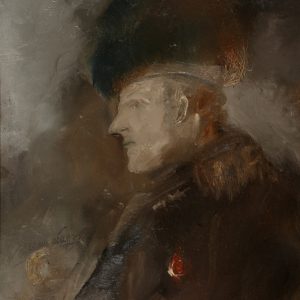Description
Artist/Maker: Yannis Papayannis (b. 1962)
Object/Materials and Techniques: Acrylic on Paper
Date: Painted in 2010
Dimensions: H. 30 cm. x W. 40 cm.
Art style: Abstract Art / Pop Surrealism / Lowbrow Art
Current Location: Artist’s collection
Curator’s note: |’n Art| presents three paintings from a series of works Yannis Papayannis felt like creating upon his reading engagement with the book, The Greeks and Greek Love, by James Davidson. The book deals with the complex world of love and homosexuality in Ancient Hellas from where the artist selected some intriguing stories to illustrate giving onto his works a sort of comics effect based on underground aesthetics.
In this artfully executed series the artist, founding himself attracted to comics, hot rod culture and underground cartoonists, chose to display narratives of mythology and classical antiquity in a distinctly ostentatious and tawdry manner. By means of a near-esoteric devotion to the act of making, along with a spirit of experimentation, he came down to develop his work within an exceptionally polished imagery acted upon comics characters and setting, as how one could describe Lowbrow art, also known as Pop Surrealism.
Towards that end, cartoon-tainted portray and motifs, in their simplicity, suggest a strong thought-provoking allegory as they enliven ancient myths and stories or further spotlight the alluring of a mythological scenery that ends up in transcending this particular series of artworks to become universal and timeless.
The oeuvre The Three Stones from the series alludes to an ancient tale/myth according to which in the Ancient Hellenic city of Plataea young couples had to face three huge oval-shaped rocks in order to finally be together. The winged Eros, the ancient god of sensual love and desire, prostate of the ones in love, in an attempt to help them overcome the obstacles, is depicted hustling to provide them valuable aid.
Eros functions as deus ex machina (English: god out of the machine), the unexpected saviour that unravels and resolves the otherwise irresolvable plot situation promising to bring the tale on the road to a happy loving finale. It is known that in Ancient Hellenic drama-plays a seemingly unsolvable problem or an apparently complicated inconvenience was suddenly and unexpectedly solved with a god’s timely appearance in the sky, achieved through the use of a crane, an established stage dramatic plot device.
On this wise, in Yannis Papayannis’ painting act the effect of the winged Eros functions as deus ex machina, and constitutes a direct and immediate response to the inconvenient factor that causes grand trouble. Additionally, just like the audiences of the theatrical plays in ancient times, today the viewers of the The Three Stones oeuvre may experience a feeling of wonder and astonishment due to this divine intervention that ‘brings order out of chaos and solves the crisis’; a portrayed element that further adds to the emotional feelings and the moral effect of the depicted difficulty.
The artist, being used to foreground the seductively existence of his calm, at times, yet overall disquieting characters, in The Three Stones choose to place emphasis on the sentimental evolution that love may provoke to the leading figures, concluding to a delighted loving ending.
In essence, behind this phenomenally naive, sort of comics display, a powerful statement passes out as an echo of the generally approved expression ‘love can conquer all’. Through a unique mixing process, modern interpretations and ancient references are successfully merged with comics-inspired arrangements or icons of pop culture, poking fun while at the same time addressing diachronic sentimental matters.
Within this framework, past comes up towards future in a ‘sui generis’ fantasy set where Yannis Papayannis’ gratifying surface carry such an expressive power that for anyone who desires to interact with it turns out to be, far and wide, a highly enjoyable experience.
Notation:
- James Davidson is a British classical scholar and history professor at the University of Warwick in England, and a regular contributor to the London Review of Books, among other journals. He specialises in social and cultural history and historiography of ancient Hellas, and has made significant contributions to the study of ancient homosexuality. He was educated at Columbia and Oxford University, where he received a DPhil. From 2001 to 2004 he was a member of the Council for the Society for the Promotion of Hellenic Studies, and from 2000 to 2010 a member of the Classical Association Journals Board. His book The Greeks and Greek Love: a Radical Reappraisal of Homosexuality in Ancient Greece was awarded three international prizes for history among which the Mark Lynton History Prize in 2010. He lives in London.
- Plataea was an Ancient Hellenic city located in south-eastern Boeotia, south of Thebes where the glory Battle of Plataea in 479 BC took place, in which an alliance of Hellenic city-states defeated the Persians.
- Cartooning and plenty other forms of illustration, including comics, graffiti art, animation, along with technology-based tools and techniques, appear to further advance the thriving of a new type of art stream that could be defined as Lowbrow art or Pop Surrealism; a rather successful combination of two powerful stances in art, Pop Art and Surrealism. Finding its cultural traces back in the ‘mainstream’ Los Angeles of the late 1960s, in street art or onto the crude artworks of underground cartoonists, as displayed on the walls of alternative galleries in California and New York, nowadays, the new audacious creative art field with its unconventional character, is assuredly here to stay.
Bibliographic References:
- James Davidson, The Greeks and Greek love: a Radical Reappraisal of Homosexuality in Ancient Greece, London: Weidenfeld & Nicolson, 2007, ISBN 9780297819974.
- Ricardo Martinez, From Pop Surrealism to Lowbrow – Something Got Lost in Translation, London, England, Widewalls.ch., December 5, 2015. Archived from the original on December 11, 2015. Retrieved December 16, 2018.
- Diana Ferguson, Greek Myths and Legends, Collins and Brown, New York, New York, 2000.
- John Pinsent, Greek Mythology, Peter Bedrick Books, New York, New York, 1982.
- Rush Rehm, Greek Tragic Theatre, Routledge, London, 1992, ISBN 0-415-04831-1.
- Malcolm Heath, Poetics. By Aristotle, Penguin: London, trans. 1996, ISBN 978-0-14-044636-4.


![Yannis Papayannis - The Three Stones (2/3) [From a series after the book The Greeks and Greek Love, by James Davidson]](https://storage.googleapis.com/n-art.org/2019/04/PAPAGIANNIS-2.9.jpg)



